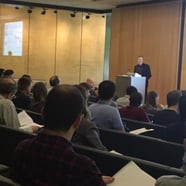Collaboration Brings Success for the UK Adaptive Designs Working Group.

The Adaptive Designs and Multiple Testing Procedures Workshop (ADMTP), the first joint meeting of the Adaptive Designs Working Group of the MRC Hubs for Trials Methodology Research and the joint ADMTP Working Group of the International Biometrics Society German and Austro-Swiss Regions, took place in Cambridge, UK last month. 
We took the opportunity to talk to Dr. James Wason, Programme Leader-Track at Medical Research Council, Dr. Thomas Jaki, Professor of Statistics at Lancaster University and co-chair of the MRC’s adaptive designs working group and Dr. Rene Schmidt, Co-Chair of the ATMTP Working Group about the collaboration, aspirations and their work in multi-arm multi-stage designs.
How has the collaboration formed between MRC Hub for Trials Methodology Research Adaptive Designs Working Group, the joint ADMTP Working Group of the International Biometrics Society German and Austro-Swiss Regions?

Thomas: Ever since I've started my research career, about twelve years ago, I've been a member of the IBS Region Austro-Swiss and been involved with the working group. About eight years ago, the MRC decided to put a substantial investment in trials in the UK and, as part of that, the Adaptive Designs Working Group in the UK was formed.
I was involved in the MRC funding and the MRC project and became one of the leaders of the Adaptive Design Working Group in the UK. I was aware that there was a separate group already working in the space, and it was immediately obvious, to ask, "OK is there a way that we can collaborate?" We reached out and discussed whether we could have a joint meeting. That was five years ago, and today we have run the first event.
What are your aspirations for the collaboration over the next 5 years?

James: Over the next five years, I see the priority as helping to take the theories on adaptive designs we have been working on and successfully implement these in practice.
Is software development your main route in terms of getting the implementation into practice?
Thomas: There is a big outreach project going on from our Working Group at the moment. Software is one component, there are papers, courses and various different activities. We have a buddying scheme, for example, to support people running the studies, in the hope, that five years down the line they can do it themselves.
James: Having more specialised courses on certain types of adaptive designs would also be useful. It’s something we would like to do more of in the future -training people in the methodology and the software available. The Working Group has plans to publish a paper that aims to cover why people should use adaptive designs, how to use them and how to report them.
Adaptive designs are becoming more mainstream, you hear more about them within clinical meetings where you wouldn't necessarily expect to hear about them a few years ago.
In what ways does the workshop support your goals?
Rene: Today’s workshop proves that this is a very successful story, adaptive designs were proposed by Peter Bauer1 and the message first spread into the German speaking regions, now extending to the UK as well. I think this is a good step for us.
With clinical trials increasing in complexity, the role of a statistician is becoming more influential. What would be your main advice for aspiring biostatisticians?
James: Statisticians are expected to have a wide range of knowledge in clinical trials. Adaptive design is quite a narrow area compared to the full spectrum of clinical trial methodologies. I would say try to find an area that you're interested in and that there is a need for more methodology, but also look out for how that area interacts with other topics; for example, missing data and adaptive designs – this could become an interesting combination.
Thomas: The risk for a Ph.D. student is to focus on a very specific topic. The student can become one of five people that really understand that specific topic, but it’s important to also look beyond this. This should be both during the Ph.D. and even during your preparatory training. If you are considering master's level training, and if you know what you want to do, then you need to be selective about the degree you choose. For example; there are Masters in statistics, biostatistics and biometry.
Rene: From the biostatistical perspective it is an interesting time due to the increasing prevalence of individualized therapies, which implies a complete change of trial concepts. The answer must not be to forget the established quality criteria of an error rate control. Instead, biostatisticians should try and come up with new ideas, in a new context that considers individualized treatment. So it’s a very inspiring time right now for biostatisticians.

What are you working on in terms of time-to-event data for survival?
Thomas: I am involved in a couple of projects in this area. The first is a general area, it's around how to do estimation after an adaptive trial and one of my post-doctoral researchers has delivered a talk that looked at subgroup selection and the methods as well as how you should do estimation after a two stage design.
We have thought about how you do time to event multi-arm multi-stage designs. Obviously we have some topics; but we're essentially stuck at this question of “how do you make your selection?” One of the major drawbacks of any adaptive design is that an interim analysis is only helpful if you can observe your primary outcome relatively quickly. With a time to event endpoint that is rarely the case. The first challenge is how can you make the selection more quickly, and then how can you characterize the relationship between your primary endpoint and what you've used to make the selection. That’s where we are at the moment.
Have you done any comparisons between methods (MAMS vs P Value combination)?
Thomas: We have done a small illustrative comparison in one of our papers: Flexible sequential designs for multi‐arm clinical trials2. In this, we talk about how we can update boundaries based on unexpected dropped treatments. As part of that paper, we have conducted some comparisons of these methods. There are more comprehensive comparisons out there. I think Tim Friede3 and Patrick Kelly4 have done some work on this.
Have there been any computational improvements since your paper 'Optimal design of multi-arm multi-stage trials' 5 was published in July 2012?
Thomas: The improvements from our side have come from moving away from our software and into a more basic programming language, which has helped a little bit in terms of time. But ultimately; the fundamental problem of computing ten stages hasn't changed in that respect. There is a more recent paper that looks at how we can restructure the problem in order to get faster computation6.
Thank you for taking the time to talk to us. It has been very insightful learning about your journey and it’s great the first event has been such a success, we look forward to the next one.
Interested in exploring innovative trial designs? Join us at the East User Group Meeting 2017, Clinical Trial Innovations Forum and East® Training, 25th and 26th October, Cambridge MA. Click the button for the full agenda and registration details.
References:
1) Bauer P. Multistage testing with adaptive designs. Biometrie und Informatik in Medizin und Biologie 1989; 20:130–148. Bauer P, Köhne K. Evaluation of experiments with adaptive interim analyses. Biometrics 1994; 50:1029–1041, correction in Biometrics 1996, 52:380
2) Magirr, Dominic, Nigel Stallard, and Thomas Jaki. "Flexible sequential designs for multi‐arm clinical trials." Statistics in medicine 33.19 (2014): 3269-3279.
3) Friede, Tim, and Nigel Stallard. "A comparison of methods for adaptive treatment selection." Biometrical Journal 50.5 (2008): 767-781.
4) Kelly, Patrick J., et al. "A practical comparison of group-sequential and adaptive designs." Journal of Biopharmaceutical Statistics 15.4 (2005): 719-738
5)Wason, J. M. S. and Jaki, T. (2012), Optimal design of multi-arm multi-stage trials. Statist. Med., 31: 4269–4279. doi:10.1002/sim.5513
6)Ghosh, P., Liu, L., Senchaudhuri, P., Gao, P. and Mehta, C. (2017), Design and monitoring of multi-arm multi-stage clinical trials. Biom. doi:10.1111/biom.12687


